A Decade of Breakthroughs! Domestic Medical Devices Reach Nearly 70% Substitution Rate, Reshaping the Global Landscape
Domestic substitution, in the development of medical devices in our country in recent years, this topic has remained a hot topic, and it is also a long-term strategic direction for many细分领域. 似乎最后一部分没有完全翻译。让我继续完成整个句子的翻译。 Domestic substitution, in the development of medical devices in our country in recent years, this topic has remained a hot topic, and it is also a long-term strategic direction for many specialized fields, as well as an important focus for companies in formulating technology breakthrough routes and market layouts.
After nearly 10 years of "golden" development, to what extent has the domestic production rate of medical devices in our country developed? Which equipment has achieved a breakthrough from 0 to 1, which sectors can already keep pace with foreign giants, and in which technological fields are we still striving to catch up? Perhaps from the following summary of data, we can glimpse the true progress of domestic substitution in medical devices.
From "0" to "1", the Breakthrough List of Domestic Medical Devices
As of 2024, under the 1170 secondary product categories in the Catalogue of Medical Device Classification (Note: excluding in vitro diagnostic reagents), the localization rate of product registration (with a localization rate of domestic products exceeding 75%) reached 67.01%, covering 784 secondary product categories. The number of secondary categories with a localization rate of product registration exceeding (including) 50% increased from 872 in 2020 to 1011 in 2024.
Note: Product registration domestication rate = (Number of domestically registered products under the secondary category of the NMPA classification directory / (Number of domestically registered products + Number of foreign-registered products)) * 100%
Table 1 Distribution of Domestic Production Rate Intervals for Secondary Product Categories of Medical Devices in China as of 2024
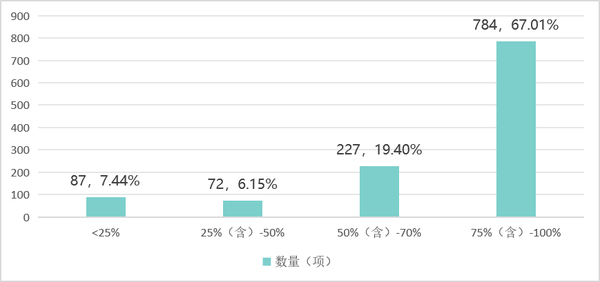
Data source: High-end Medical Equipment Institute Data Center, Medical Device Innovation Network
Table 2 Changes in the Number of Secondary Product Categories with a Domestic Registration Ratio ≥50%
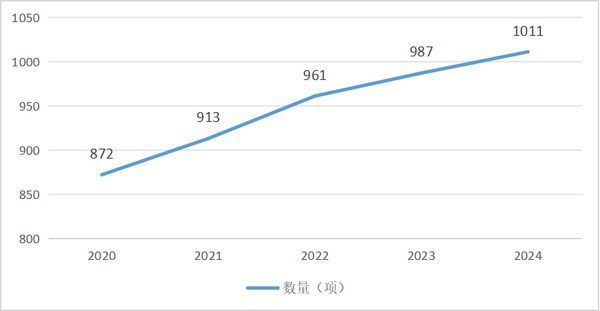
As of the end of 2024, among the 1170 secondary product categories in the Medical Device Classification Catalog, there are 30 secondary categories of products in our country that only have import product registration certificates, with no domestic products approved yet. This number has decreased by 37 from 2020. It is not difficult to see from the following data that the process of domestication of product registration in our country, from "0" to "1", is steadily advancing.
Table 3 Number of Second-Level Category Products with Zero Domestic Registration Certificates in China from 2020 to 2024
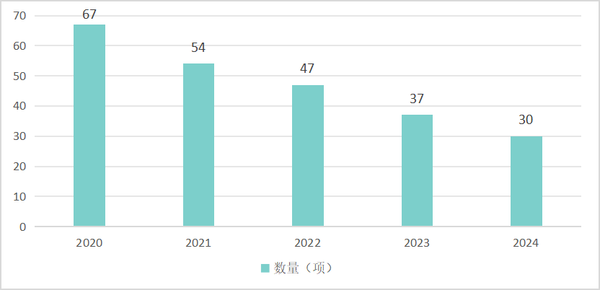
Data source: High-end Medical Equipment Institute Data Center, Medical Device Innovation Network
From a specific field perspective, our country has six second-level category products that achieved a "zero" breakthrough in 2024.
Table 4 List of Second-Level Categories for Domestic Breakthroughs Reaching "Zero" in 2024
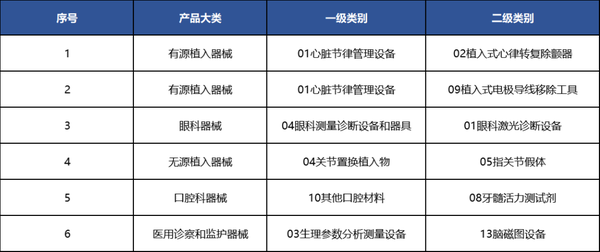
Data source: High-end Medical Equipment Institute Data Center, Medical Device Innovation Network
Further细分来看, in 2024, there were a total of 29 second-level categories of products in our country that only received 1 domestic product registration certificate. Note: "细分" is directly translated as "细分" here, but for a more natural English translation, it could be "Further breaking it down," or "Looking at it in more detail,". If you prefer a fully natural English expression, please let me know!
Table 5 List of Secondary Categories with Only 1 Domestic Product Registration Certificate in 2024
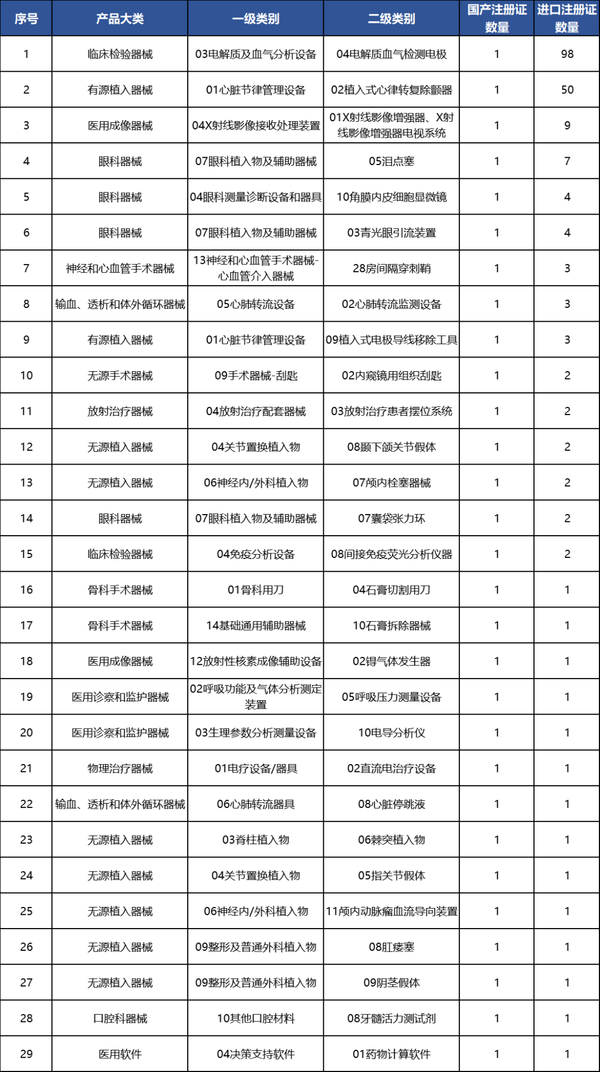
Data source: High-end Medical Equipment Institute Data Center, Medical Device Innovation Network
The products that have not yet achieved zero breakthrough are mainly concentrated in the fields of active implantation, radiation therapy, and medical imaging, among which implantable cardiac defibrillator lead wires are the most, with a total of 14 import registration certificates approved.
Table 6 List of Second-Level Category Products with Zero Domestic Registration Certificates in Our Country as of 2024
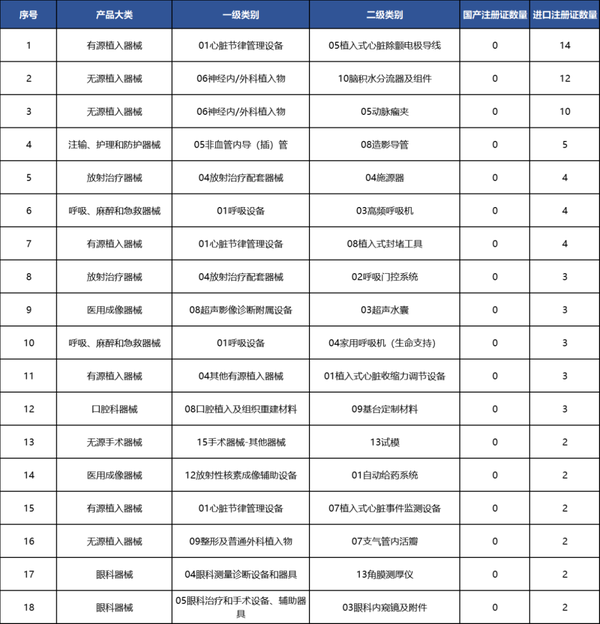
Data source: High-end Medical Device Institute Data Center, Medical Device Innovation Network
The path from 10% to 80% is full of hardships, and the breakthrough from 0 to 1% is even more difficult —— like a seedling growing in the crevice of a rock, it must break through the strata of technological blockade and also adapt to the storms of market testing. This is precisely a vivid portrayal of the development journey of domestic equipment.
mature track, a market of billions increasingly dominated by domestic products
Low-value consumables: Dominating the market in maturity phase
High-value consumables: replacement rate exceeds 80%
丨Monitoring Equipment and Biochemical Diagnosis: Mid-range Market Breakthrough
According to statistics, the domestic substitution rate of monitors in our country is about 70%, with companies such as Mindray Medical and Yuwell Medical expanding their market share through intelligent upgrades (such as remote monitoring, AI early warning). The domestic production rate of biochemical diagnostic reagents is 60%-70%, mainly benefiting from the cost advantages of domestic enterprises and the demand for tiered diagnosis and treatment policies.
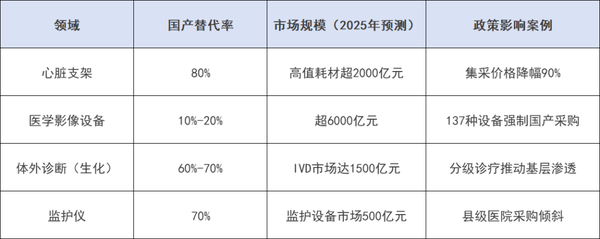
Charting: Medical Device Innovation Network
Apart from some products with higher maturity having a relatively high degree of domestication, there is still a large part of the medical equipment market share that needs to be improved. In recent years, with the iteration of innovative technologies and policy support, some medical equipment has shown a trend of breaking through.
For example, high-end medical imaging equipment, according to statistics, the domestic substitution rate for CT, MRI, and other high-end medical imaging equipment is only 10%-20%, with foreign brands (such as GE, Siemens) still monopolizing the market in tertiary hospitals. However, companies like United Imaging Healthcare have achieved technological breakthroughs, with their PET-CT equipment capturing over 30% of the new market share domestically, and gradually entering the European and American markets.
Policy-driven, domestic substitution enters the "critical period"
In 2023, the "Guiding Standards for the Review of Government Procurement of Imported Products" jointly issued by the Ministry of Finance and the Ministry of Industry and Information Technology set domestic procurement ratios for 178 types of medical devices, with 137 types requiring 100% domestic production, directly promoting a shift in procurement at tertiary hospitals. In 2023, the central government allocated 20 billion yuan to support equipment procurement at county-level hospitals, clearly stipulating a preference for domestic products. The inclination of procurement policies is also a major driver in accelerating domestic substitution.
In addition, the normalization of centralized procurement is also accelerating the rise of domestic products, with categories such as cardiac stents and artificial joints seeing price reductions of over 80% through centralized procurement, forcing foreign capital to exit the mid-to-low-end market, and domestic enterprises taking the lead due to their cost advantages.
At the same time, our country is continuously increasing its efforts to tackle the technology of core medical device components. In the Ministry of Science and Technology's key R&D plan for the 14th Five-Year Plan, over 5 billion yuan has been invested in the medical equipment special project, supporting the development of critical components (such as CT tubes).
The rapid development of medical devices is also inseparable from the improvement and efficiency enhancement of the approval process. In recent years, the special approval procedure for innovative medical devices has reduced the product launch cycle by 30%. In 2024, a total of 62 products were approved through this channel, an increase of 25% year-on-year.
Going out to explore a broader global world has also become an important means for domestic development. Currently, our country is promoting the export of domestic equipment through the "Belt and Road" initiative, with medical equipment exports increasing by 18% year-on-year in 2023, and Southeast Asia becoming the main market.

Currently, the domestic substitution of medical devices in our country has shifted from low-end consumables to high-end equipment. Policies, technology, and capital have formed a synergy. More encouragingly, we are seeing more and more products evolving from non-existence to existence, and from existence to strength, gradually writing their own stories of domestic brands.
Over the next five years, the replacement of high-end equipment in tertiary hospitals, the localization of core components in the industrial chain, and globalization will become the three main themes. Companies need to focus on differentiated innovation based on clinical needs, while the policy side needs to continuously optimize the procurement environment and R&D ecosystem to seize more market share under new opportunities.
We will also conduct a detailed analysis of the domestication process of medical equipment in our country from the perspective of market share, so stay tuned.
【Copyright and Disclaimer】The above information is collected and organized by PlastMatch. The copyright belongs to the original author. This article is reprinted for the purpose of providing more information, and it does not imply that PlastMatch endorses the views expressed in the article or guarantees its accuracy. If there are any errors in the source attribution or if your legitimate rights have been infringed, please contact us, and we will promptly correct or remove the content. If other media, websites, or individuals use the aforementioned content, they must clearly indicate the original source and origin of the work and assume legal responsibility on their own.
Most Popular
-

Brazil Imposes Five-Year Anti-Dumping Duty of Up to $1,267.74 Per Ton on Titanium Dioxide From China
-

Mexico officially imposes tariffs on 1,400 chinese products, with rates up to 50%
-

MOFCOM Spokesperson Answers Questions from Reporters on China-U.S. Kuala Lumpur Trade Consultations Joint Arrangement
-

"Golden October" Weak, Polyethylene Prices Hit New Low of the Year in October
-

Kingfa Sci & Tech Q3 Net Profit Attributable to Shareholders Rises 58.0% YoY to 479 Million Yuan






